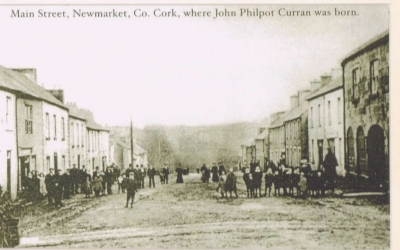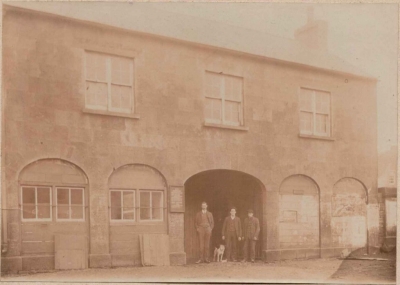A Brief History of the CYMS
The CYMS, is a fine two storey, limestone clad, building, located to the side of the Church on Main Street, facing down the steep hill of High Street. It was originally built as a market house and court house around the year 18101 a focal point of a ‘Market Town’. It played a very important role in the local economy of the region and the increasing commercialisation of agricultural activities in the eighteenth century. These and other civic or public services buildings were usually sponsored or instigated by local landlords, in this case the Aldworths, who collected taxes from both the markets and the fairs.
The original building is over 200 years old and has had many different functions over the years. The ground floor was originally an open air market complementing the nearby Fair Field. The Courthouse was on the first floor and was accessed from the back by two stone stairs. The above picture,taken at the beginning of the 20th. century shows the building with its arcaded ground floor which seems to have been enclosed by this time as the various markets were now being held on the side of the streets. The Courthouse was still in use at this time and the RIC man standing in the background reminds us that British Law supported by the Royal Irish Constabulary was still in force. Petty sessions were held in the courthouse at regular intervals where minor cases were tried and and where more important matters were referred to higher courts. According to Davis (2) John Philpott Curran’s Father had an official function at these Petty Sessions. We have the following brief mention from 1846:
“Petty Sessions are held every Saturday in a new Courthouse near which the market is held”(3)
From the above it seems that the days on which the Petty Sessions were held varied from time to time. The next reference we have to the Courthouse is in 1863 in connection with Newmarket’s most famous son.
“1774 October 16th John Philpott Curranesq and Sarah Creagh, both of this parish were married by license by the curate Henry Weston, in presence of Richard Odell and Jeremiah Keller,(Par.Reg.). The celebrated Curran,whose memory is still affectionately remembered in the land of his birth,was born on or about 24thof July or August,1751, in a house which has long been removed, which stood to the west of the present Courthouse in Newmarket. (4)
The following reference from 1888 reflects the turbulent years of the Land War at the end of the 19th.century
“Captain Stokes and Captain Seagrave R.Ms, sat at Newmarket Petty Sessions to hear the case against John Browne, Maurice Collins, Jeremiah McAuliffe, Gerald Browne and Charles McCarthy, for taking part in a meeting of the suppressed branch of the Irish National League at Meelin, County Cork, on the 13th of November. ” (5)
In July 1894 John Twiss was remanded in custody in Newmarket Courthouse by Major Hutchinson, local Resident Magistrate and so began one of the most infamous trials in Irish legal history.(6)
By 1914 the Courthouse was still being used on a regular basis and The Petty Sessions were held on alternate Saturdays. (7)
25 years after the unfortunate John Twiss began his long journey to the gallows the administration of British justice in the Newmarket area was dealt a deadly blow when the local IRA burned the Courthouse during the War of Independence.
“During 1919 it was strongly rumoured that a military garrison was due to occupy Newmarket. So it was decided to destroy the Courthouse, which was a very likely place for occupation. The Courthouse was the upstairs portion of a two-storey building and the lower part of the premises was a very large egg store. Under charge of Seán Moylan, and with Bill Moylan and D. McAuliffe, our company, a lot of whom were armed, assembled at the premises one night. We removed a huge quantity of egg cases, timber ad other stores and successfully destroyed the whole building including all the Court records.” (8)
It is more than probable that this attack only destroyed the first floor of the building but that the well built stone structure of the building survived and would eventually play a central role once more in the town of Newmarket.
Local historian Raymond O’ Sullivan records that older inhabitants of the town recalled the courthouse being sometimes used to provide concerts and entertainment for the local gentry during the 19th Century and it is interesting that the new role of the old building would be to provide recreational and social services for the community. At sometime after the foundation of the State the building was obtained by the Church and reconstructed as a Catholic Young Men’s Society (CYMS) hall and this hall played a major role in the life of the town down to the present day. The following photograph, kindly presented by Tim Cashin, seems to record the restoration of the building for this purpose.
As a CYMS hall it provided a club house for the young men of the parish and many will fondly remember the magnificent snooker/billiard table which was the centerpiece of the first floor club house which was also the scene of keenly contested card games. The ground floor rooms provided local clubs with meeting rooms. Saint Mary’s Secondary school had its junior classes in these rooms until 1954/5 when the school moved to the Protestant Church. In recent times the building has undergone considerable renovation. Mass was celebrated there when the Church was being renovated.
The Newmarket Dramatic Society staged many of their productions there after the building underwent a major, much needed renovation in 2002, spear headed by the late Father Anthony Cronin and a committee of local people. The first play the group performed there was their award winning production of John B. Keane’s ‘Many Young Men of Twenty’. Among the many plays they performed there, were ‘Dancing at Lughanasa’, ‘Out of Order’. ‘Holiday Snap’, ‘Don’t dress for dinner’, ‘Caught in the act’, ‘Lend me a Tenor’. More recently the group performed a play by local playwright Mike Guerin called ‘Alpha’ in Meelin hall.
A new hall committee was formed in 2013 and a huge amount of work has been undertaken. The stage was removed, the floors replaced and some much needed renovations were undertaken. A wide range of groups and clubs use the hall on a weekly basis: the parent and toddler group, irish dancing classes, ballroom dancing, exercise classes, junior GAA club training, Foróige along with various parties and meetings. This year there will be more work undertaken to improve the hall and make it a facility that can be used by an increasingly larger range of clubs and groups. You can follow current developments and news about the CYMS on Facebook (search for Newmarket CYMS).
This stately building has had many roles over the last 200 years of it’s existence: it has been an economic centre, a court-house, a school, a theater, a temporary church and a place for all of us, young and old, to gather together. With recent renovations and exciting new plans in the pipeline, it is clear that it will remain at the heart of our community for many more years to come.
by Eilis Hourigan
References:
-
An Introduction to the Architectural Heritage of North Cork, National Invenntory of Architectural Heritage (2009).
-
Davis,Thomas, Curran’s Speeches (1845)
-
Slaters Directory (1856)
-
Brady , Dr. William Mazier Clerical and Parochial Records of Cork, Cloyne and Ross (1863).
-
The Irish American , week ending January 21. 1888.
-
Lynch,Pat, They Hanged John Twiss (1982).
-
Guys Postal Directory (1914).
-
http://www.Bureauofmilitaryhistory.ie/reels/bmh/BMH.WSO76
Thanks to the following who helped with this article: Catherine Culloty, Teresa O’Keeffe, Séamus Ó Cróinín and Raymond O’Sullivan.
If you have any further information about the history of the hall we would love to hear from you. You can get in touch with us at contact@athtrasna.com



